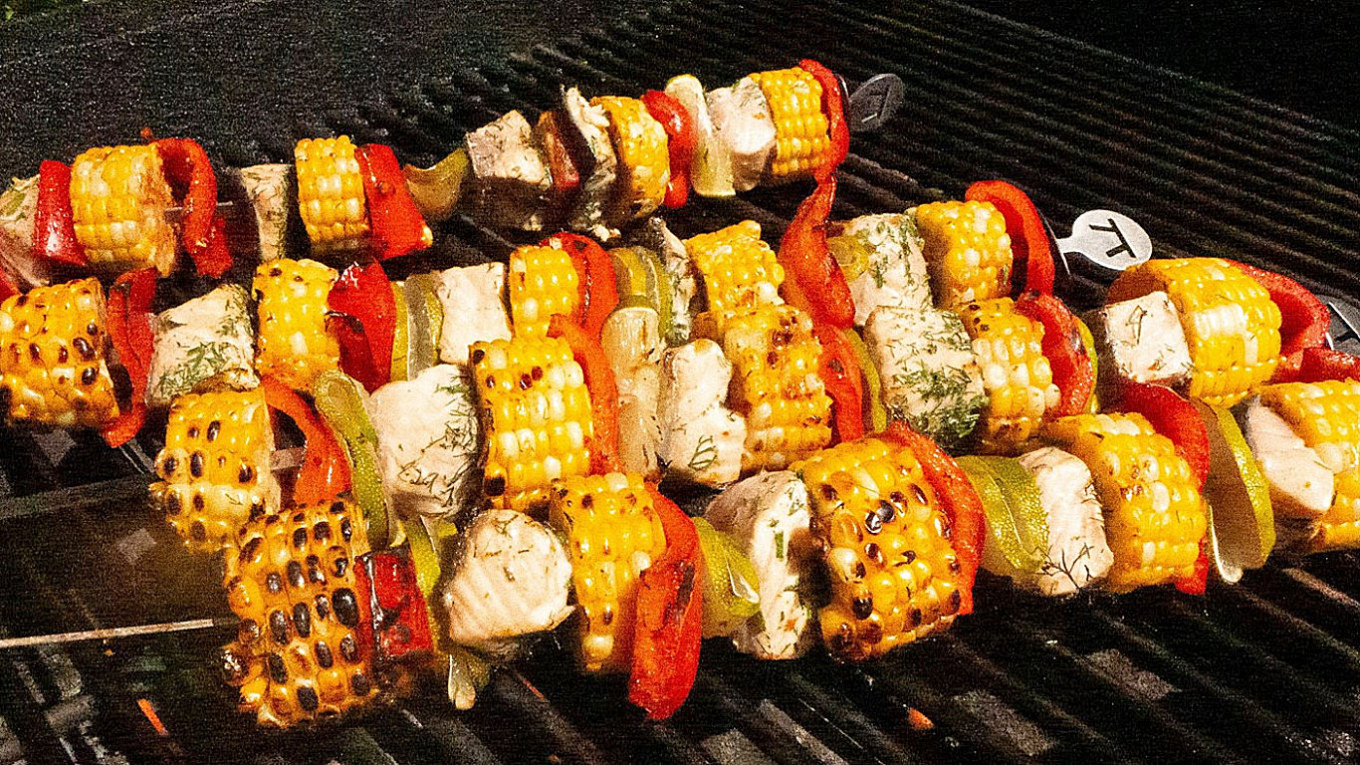And just like that, it’s August, a month when almost anything can happen, and in Russia usually does. Each year the country braces itself for “The August Curse,” the month’s propensity towards natural disasters from hurricanes to floods, and even peat bog fires, combined with a tragic number of air and rail crashes and the Kursk submarine accident. August also plays host to military, social, and political upheavals, such as the declaration of World War I and the 1991 hardliner coup, which this year celebrates its thirty-year anniversary.
So, while we brace for something seismic, let’s try to enjoy some upsides of August — and corn season is at the top of the list. As this relentlessly cheerful crop climbs to the height of an elephant’s eye, it’s time to pull out all our favorite corn recipes: cornbread, corn muffins, corn chowder, polenta, and of course, just plain old corn-on-the-cob. Slathered with butter and sprinkled with a little salt. What could be nicer?
How about corn shashlik? Cut into chunks, corn ears do very well on a shashlik skewer, and pair well with everything from fish to vegetables.
Before we construct the skewer, however, let’s look back at the storied history of corn in Russia, and the outsized role corn played in nurturing better relations between the country and its superpower adversary: the United States.
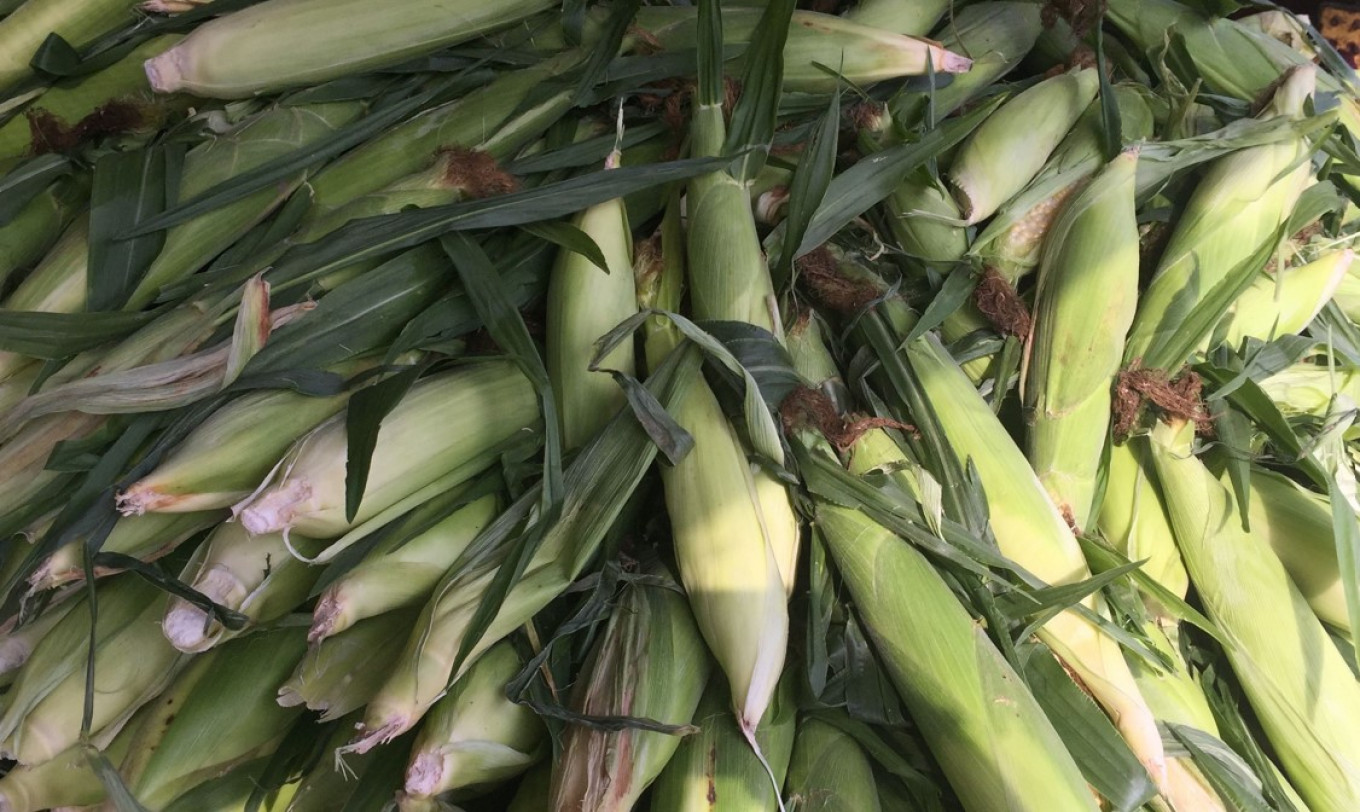
Khrushchev, Iowa and corn
Eclipsed in pre-revolutionary Russia by wheat, rye, oats, barley, and buckwheat, corn was primarily cultivated in the Black Soil region of Bessarabia (present day Moldova). Heavily influenced by Rumanian culinary culture, corn porridge, known as mămăligă, is still a popular dish in that region. But in the rest of Russia, corn was unknown or considered suitable fodder for animals rather than food for humans.
It would take a Soviet premier and a capitalist corn seed salesman from Iowa to change the corn calculus for Russia. In one of the Cold War’s more enduring relationships, Roswell Garst of Iowa and Nikita Khrushchev forged a friendship during Garst’s repeated visits to Moscow and Khrushchev’s memorable visit in 1959 to Iowa. Corn was the catalyst for the friendship and remained at the core of their decades-long friendship, which continued after Khrushchev was ousted from power in 1964.
As a former sheep herder on the borderlands between Russian and Ukraine, Khrushchev came to power with broad knowledge of agriculture and a drive to modernize Soviet farming and dramatically increase yields by increasing cultivation in areas of the USSR that had never been farmed before. Khrushchev hoped that this “Virgin Lands” program would ultimately yield more livestock, essential for a population still lacking sufficient protein in their diet.
Large-scale cultivation of corn emerged as a solution thanks to a timely editorial in 1955 by Lauren Soth of the Des Moines Register, entitled “If the Russians Want More Meat.” Soth’s editorial, which won the 1956 Pulitzer Prize for Editorial Writing, offered hybrid corn as a no-nonsense solution to the Soviet Union’s insufficient agricultural yield. It also included a heartfelt — if unsanctioned by the U.S. State Department — invitation for Soviet delegations to visit Iowa and learn everything the Corn Belt had to offer: “Everything we Iowans know about corn… will be available to the Russians for the asking.” Soth finished on a pragmatic note. “Of course, the Russians wouldn't do it. And we doubt that even our own government would dare to permit an adventure in human understanding of this sort. But it would make sense.”
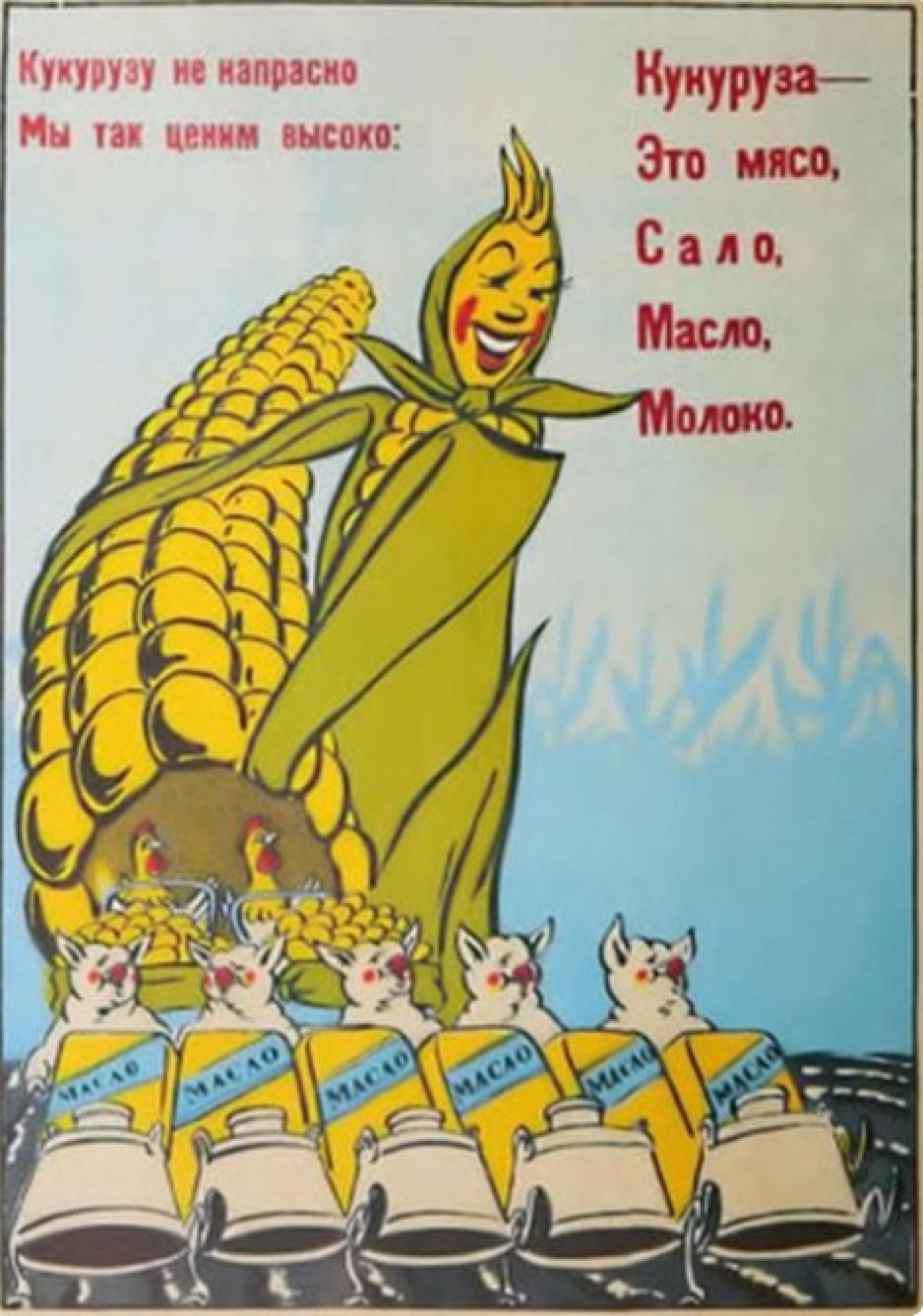
To everyone’s astonishment, Khrushchev agreed. It did make sense, and the State Department scrambled to arrange to receive a Soviet trade delegation. It was during this initial trip that Iowan Roswell Garst showed off his efficient seed plant with its state-of-the-art machinery and mechanization. Returning home, the Soviet delegation sang the praises of Garst and his plant to Khrushchev, which paved the way for Garst to visit the Soviet Union. There, he met with Khrushchev and Anastas Mikoyan, then first deputy premier. It was from Garst that Khrushchev first learned to call corn ears “little sausages,” a phrase the Soviet Premier would repeat frequently in the coming years.
Garst’s relationship with Khrushchev was unique, and Western journalists found his access to the premier and his family astonishing. Over the years as Garst continued to travel to Eastern Europe, and he and his family hosted the Khrushchev family on their farm during Khrushchev’s memorable trip to Iowa in 1959.
Garst’s advice fell on fertile soil. Heedless of the suspicion of Soviet farmers that corn was an “alien” crop, Khrushchev steamrolled ahead with robust cultivation of corn, increasing a scant 4.3 million hectares to over 60 million acres in 1962. Thanks to hot, dry weather, the first years of corn cultivation were a great success, but cooler, rainy weather in 1962 led to a disastrous loss of almost all the corn crop of the U.S.S.R. Two years later, Khrushchev was forcibly removed from power, his failed agricultural program just one pretext for his demise.
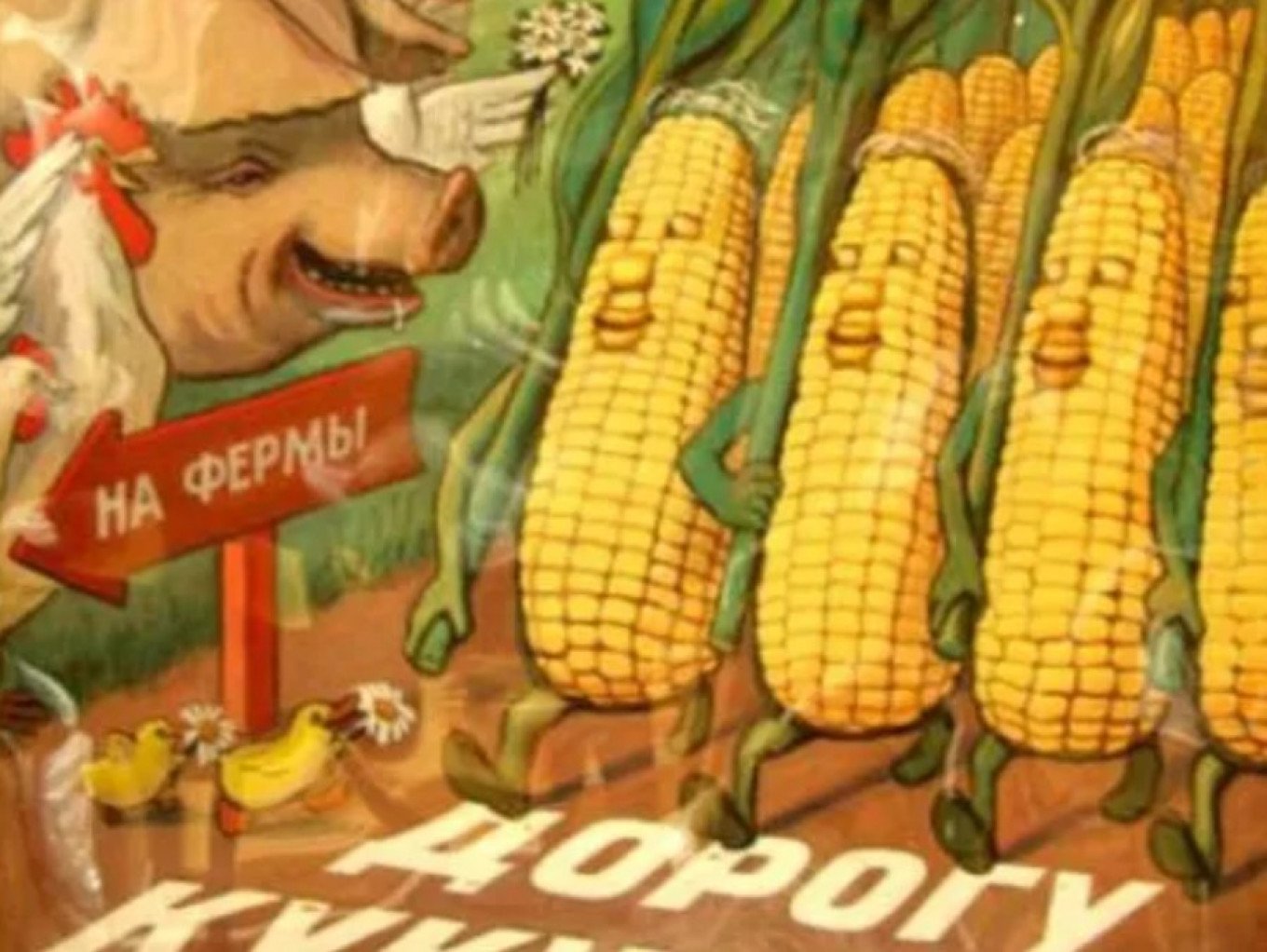
Post-Soviet corn revival
After perestroika, when fast-food chains entered the Russian market, the popular fried chicken chain Rustic’s — today a KFC franchise — reintroduced corn-on-the-cob as a popular side dish. While corn is in no danger of eclipsing potatoes or buckwheat in mainstream Russian cuisine, it remains popular, particularly when it comes into season. Which is right now.
There are so many ways to enjoy fresh ears of corn but grilling or roasting brings them out the natural sugars in corn’s kernels and enhances the already fabulous flavors of corn. Grilled corn is perfect alongside just about anything else you want to throw on the grill, but in the spirit of Nikita Khrushchev and Roswell Garst, here is a shashlik recipe that combines fresh corn-on-the-cob with salmon — two distinct ingredients from very different culinary canons meeting halfway in the middle for a delicious exchange. Lightly curing the salmon ahead of time and pre-cooking the corn means that these skewers need only a few moments per side on the grill, removing any danger of either scorching or becoming too dry. Red pepper gives this skewer a nice color palette and thin slices of lime add a spritz of citrus to the salmon.
So in the spirit of international friendship, throw these salmon and corn shashlik skewers on the grill and enjoy August… while you still can.
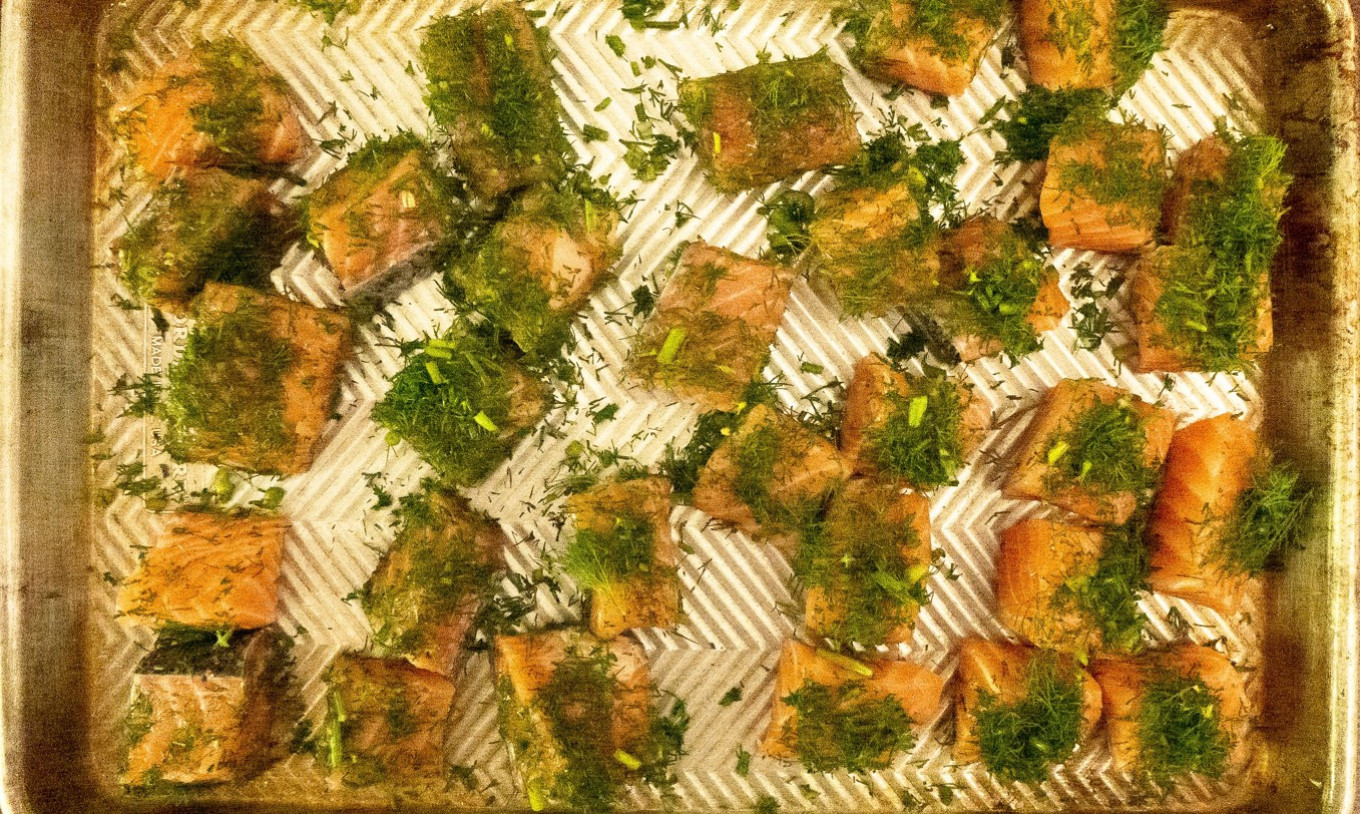
Corn and Salmon Shashlik
Ingredients
- 1 ½ lbs. (700 grams) salmon, cut into 2-inch cubes
- 3 ears of corn-on-the-cob
- 2 red peppers, cut into 1-inch pieces
- 2 limes, thinly sliced
- 1 Tbsp red pepper
- 1 Tbsp olive oil
- 4 Tbsp sea salt
- 1 large bunch of fresh dill, finely chopped
Dipping Sauce
- ¾ cup (175 ml) olive oil
- Juice and zest of one lime
- 1 Jalapeno pepper, seeds removed
- 1 cup (240 ml) fresh herbs: cilantro, dill, and mint
- 5 scallions
Instructions
- Sprinkle half of the sea salt over the salmon cubes, then gently press dill into each side of the cubes. Cover with plastic wrap and chill for 2 hours.
- Bring a pot of well-salted water to a rolling boil. Cook the corn ears for 10 minutes (longer if required by the sort of corn). Remove from the pot and cool to room temperature. When cool, cut the ears into 2-inch (5-centimeter) chunks. Toss the chunks with the remaining salt and red pepper and set aside.
- Make the dipping sauce by combining all the ingredients into a food processor fitted with a steel blade or a blender and combining until smooth. Chill the sauce until you are ready to serve.
- Pat the salmon dry with paper towel, then thread it onto shashlik skewers next to the lime slices and interspersed with the pepper and corn.
- Heat the grill to medium high and oil it with a damp wad of paper towel dipped into vegetable or canola oil. Grill the skewers 2-3 minutes per side or until the pepper is slightly charred, and the salmon has turned translucent.
- Serve immediately with the dipping sauce.
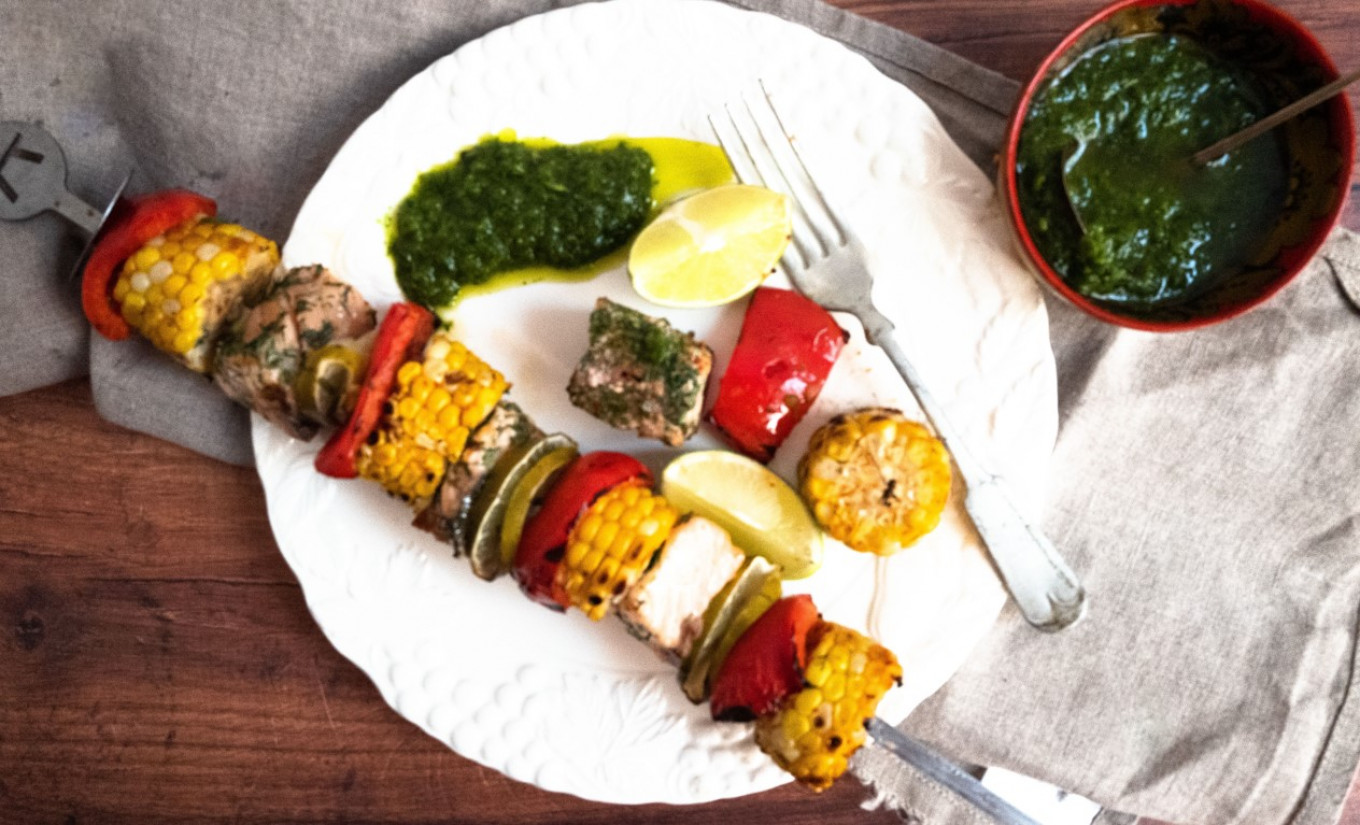
A Message from The Moscow Times:
Dear readers,
We are facing unprecedented challenges. Russia's Prosecutor General's Office has designated The Moscow Times as an "undesirable" organization, criminalizing our work and putting our staff at risk of prosecution. This follows our earlier unjust labeling as a "foreign agent."
These actions are direct attempts to silence independent journalism in Russia. The authorities claim our work "discredits the decisions of the Russian leadership." We see things differently: we strive to provide accurate, unbiased reporting on Russia.
We, the journalists of The Moscow Times, refuse to be silenced. But to continue our work, we need your help.
Your support, no matter how small, makes a world of difference. If you can, please support us monthly starting from just $2. It's quick to set up, and every contribution makes a significant impact.
By supporting The Moscow Times, you're defending open, independent journalism in the face of repression. Thank you for standing with us.
Remind me later.



